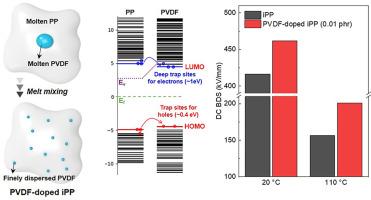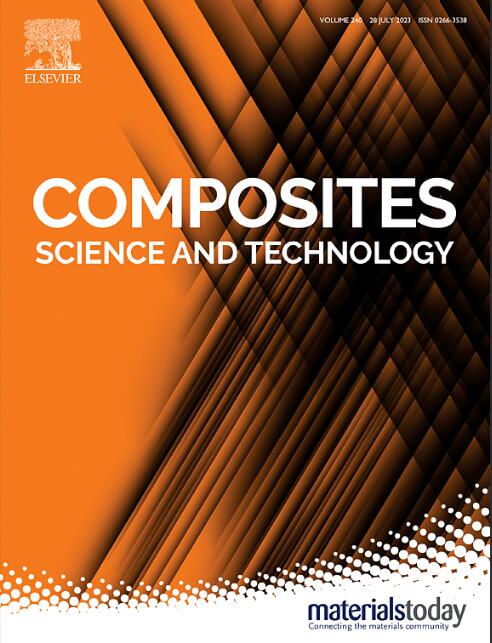Improving the high-voltage insulation properties of polypropylene by introducing trace addition of polyvinylidene fluoride: An experimental and simulation study
IF 8.3
1区 材料科学
Q1 MATERIALS SCIENCE, COMPOSITES
引用次数: 0
Abstract
Various additives ranging from inorganic nanoparticles to organic additives have been suggested to improve the insulation performance of polymeric materials for high-voltage engineering applications. Herein, a simple method for doping fluorine into a polypropylene (PP) matrix was presented by melt-blending of isotactic PP (iPP) with a small amount of polyvinylidene fluoride (PVDF) as a thermoplastic voltage stabilizer (TVS). During melt-mixing, the PVDF TVS, which is immiscible with PP, is gradually split into smaller domains within the iPP matrix and finely distributed, especially at a low PVDF content. The direct current (DC) breakdown strength (BDS) values of the PVDF-doped iPP increased by 110 % and 149 % at 25 and 110 °C, respectively, compared to those of the pristine PP, while its dielectric permittivity and loss tangent values remained nearly similar to those of iPP at wide temperature between 25 and 140 °C and frequency range between 1 Hz and 10 MHz. Quantum chemical simulation results reveal that a small amount of PVDF with high dipole moment introduces deep trap sites within the polymer matrix, which contribute for increasing BDS of iPP. Also, the PP with a small amount of PVDF dopants below 1.0 phr exhibited no any decrease in the tensile strength and elongation at break values. Therefore, the PVDF-doped iPP is anticipated as a potential candidate as high-performance high-voltage insulation materials for next-generation insulation applications.

通过微量添加聚偏二氟乙烯改善聚丙烯的高压绝缘性能:实验和模拟研究
为了改善高压工程应用中聚合物材料的绝缘性能,人们提出了从无机纳米粒子到有机添加剂等各种添加剂。本文介绍了一种在聚丙烯(PP)基体中掺入氟的简单方法,即在异方性聚丙烯(iPP)中熔融混合少量聚偏二氟乙烯(PVDF)作为热塑性电压稳定剂(TVS)。在熔融混合过程中,与聚丙烯不相溶的 PVDF TVS 在 iPP 基体中逐渐分裂成更小的畴,并精细分布,尤其是在 PVDF 含量较低时。与原始聚丙烯相比,掺杂 PVDF 的 iPP 在 25 ℃ 和 110 ℃ 时的直流击穿强度(BDS)值分别增加了 110 % 和 149 %,而其介电常数和损耗正切值在 25 ℃ 至 140 ℃ 的宽温度和 1 Hz 至 10 MHz 的频率范围内几乎与 iPP 保持相似。量子化学模拟结果表明,少量具有高偶极矩的 PVDF 会在聚合物基体中引入深阱点,从而增加 iPP 的 BDS。此外,掺入少量 PVDF(低于 1.0 phr)的聚丙烯在拉伸强度和断裂伸长率值方面没有任何下降。因此,掺杂 PVDF 的 iPP 有可能成为下一代绝缘应用中高性能高压绝缘材料的候选材料。
本文章由计算机程序翻译,如有差异,请以英文原文为准。
求助全文
约1分钟内获得全文
求助全文
来源期刊

Composites Science and Technology
工程技术-材料科学:复合
CiteScore
16.20
自引率
9.90%
发文量
611
审稿时长
33 days
期刊介绍:
Composites Science and Technology publishes refereed original articles on the fundamental and applied science of engineering composites. The focus of this journal is on polymeric matrix composites with reinforcements/fillers ranging from nano- to macro-scale. CSTE encourages manuscripts reporting unique, innovative contributions to the physics, chemistry, materials science and applied mechanics aspects of advanced composites.
Besides traditional fiber reinforced composites, novel composites with significant potential for engineering applications are encouraged.
 求助内容:
求助内容: 应助结果提醒方式:
应助结果提醒方式:


